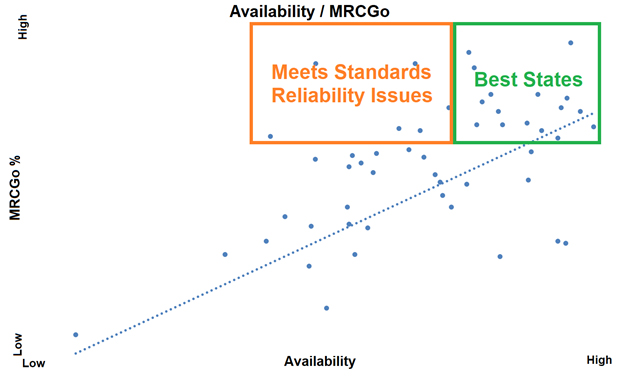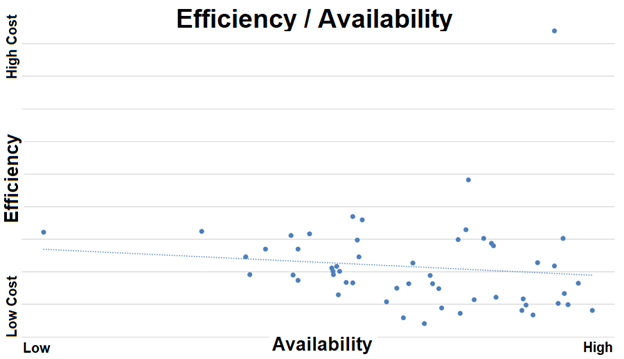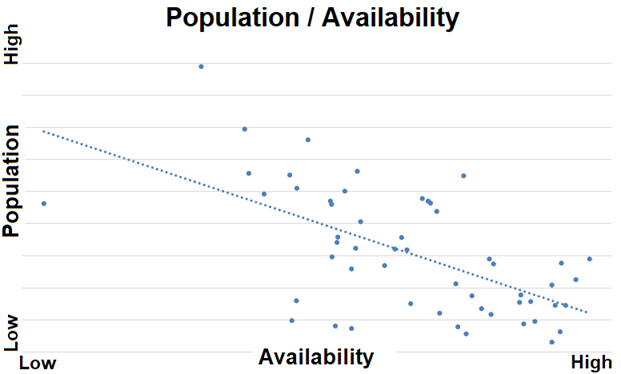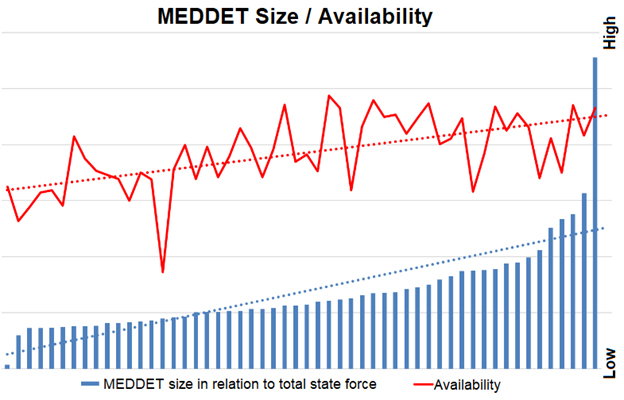Six Advantages to Utilizing a Medical Readiness Availability Rating
Franklin C. Annis
Civilian Industry has been utilizing Availability Ratings to optimize the efficiency of their organizations for years. The assessment matrix is rather simple for the insights it can provide. An Availability Rating can be calculated by the number of days a piece of equipment is operational divided by the total number of days (often measured over the last 365 days). A perfect score would be a “1”. By knowing the availability of a piece of machinery and the loss of profits per day of downtime, companies can make strategic decisions in the amount of equipment they purchase, along with the quantity of repair parts they maintain on hand, and the number of maintainers they keep on payroll to maximize profits. By innovatively applying this concept to Medical Readiness, we might take advantage of increased resource management while promoting sustained readiness.

I was first introduced to the concept of Availability Ratings by Major Jason Fincher at an event held by the Association of Marine Corps Logisticians. By measuring equipment readiness over time and attempting to increase the speed of acquisition of replacement parts and maintenance, Major Fincher was positively impacting readiness. He found that the key to maintaining a high-level of readiness may be focusing on the increasing the speed of which Marines can return non-functional equipment to a ready status.
Senior leaders continually stress the importance of Readiness. Yet, we might be able to better meet their intent by replacing the concept of “readiness” with “availability.” Readiness is an assessment of how prepared we are for war today while availability is the measure of how reliable we have been over time. If the ultimate goal is mobilizing mass numbers of Soldiers in support of ground combat operations on any given day, Availability is a far more appropriate matrix to measure this desired sustained readiness.

Hoping to improve the Readiness of the Army National Guard (ARNG), I conducted a series of trails to see if the concept of Availability could be applied to Medical Readiness. Using existing source data within the Medical Protection System (MEDPROS) and historical budget data, I was able to analyze the status and reliability of the ARNG Medical Readiness in novel ways that hold significant strategic and operational value. Instead of just judging organizations by their ability to meet Medical Readiness requirements, we could gain better insight by also utilizing an Availability Rating to provide an indication of the organizations reliability to maintain this level of readiness over time.

Adapting the Availability Rating within Medical Readiness produces multiple strategic advantages. In this paper, I will describe six key advantages: 1) Availability providing more value in less matrixes, 2) the ability to calculate the “true cost” of Medical Readiness, 3) insights provided to “right-size” medical force structure, 4) the predictive function of Availability Ratings, 5) increasing the focus on strategically important populations, and 6) better understanding of the population capable of being positively influence by Medical Readiness activities. It is important to note that there are additional advantages of utilizing an Availability Rating system that are not noted in this paper. The intent of this paper is to provide an overview of the largest strategic impacts to advance the argument of adapting this system of Medical Readiness assessment.
Availability Provides More Value in Less Matrixes
Explaining Medical Readiness to non-medical Strategic Leaders can sometimes be difficult. We have multiple matrixes and complex rules. We have four different Medical Readiness Codes (MRCs), four different Dental Readiness Codes (DRC), seven different Deployment Limiting (DL) codes, and complex rules on what codes are and are not considered “Deployable.” Additionally, Many Soldiers may be categorized as “Deployable” still require further medical or dental actions before being truly deployable. With all these complex coding, it is often difficult to provide strategic leaders short abbreviated reports on Medical Readiness that addresses their needs.
If Availability Ratings were adapted, these reports could be reduced to two numbers: the current MRCGo percentage and the average Availability Rating for the unit. In these two figures, strategic leaders would be given the information that would be required to determine the impact in a combat theater. The MRCGo percentage would report on the exact Medical Readiness status of the moment, while the Availability Rating would indicate the level of consistency in sustaining the current level of readiness. This provides the pertinent data needed to determine power projection capabilities.
The “True Cost of Medical Readiness”
By calculating Medical Readiness over time, it is possible to determine the cost for a single day of Availability (Medical Readiness) per Soldier. For want of a better term, we will use the word “Efficiency” to represent this cost. With this information and current budget expenditure, it is possible to predict if an organization has enough funds to maintain the current level of average Availability Ratings among their Soldiers for the remainder of the fiscal year. Additionally, it is a useful tool at the strategic level to project budgets into future fiscal years. Unlike utilizing MRCGo percentage as a primary measure to determine the success of a medical initiative, Availability provide a much more granular as the success or failure of programs can be determined in the number of average days Available gained or lost. This would provide a much more effective means of determining the cost effectiveness of various medical initiatives to further refine resource management.

When the Efficiency of ARNG states are plotted against their average Availability Ratings it may be possible to determine what states might have operational best practices that could be shared with other states to reduce the overall budget requirements. Additionally, it may be helpful to direct the most cost-effective states to increase their expenditures. This is especially true when their operational approaches are having a negative impact on their personnel retention due to over-working organic medical providers. By graphically displaying this information, it became apparent that state size and personnel resourcing likely are primary influencers on state average Availability Ratings.
Provides Insight on “Right-Sizing” the Force

When the average Availability Ratings of ARNG states are plotted in comparison to their population, it becomes apparent that larger organizations had more difficulty maintaining sustained Medical Readiness. It had been previously assumed that the difficulty of maintaining Medical Readiness was largely influenced by geographic dispersion of Guardsmen. However on closer examination, it appears that large population states were negatively impacted regardless of geographic dispersion.

This led to a comparison of the size of the State Medical Detachment (MEDDET) in comparison to the total size of the state Soldier population. This provided a ratio of MEDDET personnel (those providing for Medical Readiness operations) and the rest of the state Soldier population (the receivers of the Medical Readiness operations). The results of this comparison showed there was a moderate correlation between MEDDET sizes to state average Availability Ratings. This information will have great strategic values to the Army National Guard as an optimal staffing ratio to meet specific Availability Ratings could be determined. This will provide State Adjutant Generals (TAGs) actionable data in determining their state’s force structure.
Availability as a Predictor
Individual Availability Ratings are useful predictors of future readiness. While the Active Duty component has access to the Medical Readiness Assessment Tool (MRAT) to function as a predictive tool of future Medical Readiness, the Reserve Components lack a means of capturing the required medical data when Soldiers seek medical treatment outside the military medical system. However, just as having repeated profiles can be a predictor of future deployment limiting medical conditions, low individual Availability Ratings are predictive of lower levels of health and readiness.
Focuses Attention on Strategically Important Populations
Remembering our primary mission of conserving the combat strength of the Army, evaluating Medical Readiness through Availability Ratings has some distinct advantages. The Availability Rating, in itself, would provide incentives to act in a manner that meets the strategic goals of the military. By shifting the goal of maintaining Medical Readiness to that of Medical Readiness evaluated over time, we would immediately be drawn to focus on the speed of which we could return Soldiers to a Medical Ready status. It would shift the paradigm from providing Medical Readiness support operations to quickly providing these action.
If the primary assessment method shifted to Availability, organizations would target those with the lowest Availability Ratings for correction, as they would have the largest impact on the average Availability Rating of an organization. In the Army National Guard, this might mean targeting Soldiers that have been avoiding Medical Readiness Events for years. This would also encourage quickly processing those with non-retainable medical conditions into the Integrated Disability Evaluation System (IDES).
Conversely, organizations could be directed to keep deficient categories under a set level of availability. For example, the target average Availability Rating for those needing dental treatment (DL2s) might be set at less than 0.2. This would cause medical organizations to prioritize the return of the healthiest Soldiers (those with the highest level of Availability) back to a Medically Ready condition (MRCGo) as quickly as possible.
Insight on “Touchable” Population
Availability Ratings can give greater insight of the population that could be influenced by any strategic Medical Readiness campaign. Soldiers with zero reported days of MRCGo within the last year (or an Availability Rating of 0.0), are unlikely to be actionable during Medical Readiness Events. While it is true that some Soldiers with an Availability Rating of 0.0 can be converted back into the MRCGo category, there is a significant number of the population with this Availability Rating that have been chronically non-compliant, AWOL, waiting discharge, or are “ghosts” within the personnel systems. These individuals often plague ARNG MEDDETs that are pressured to achieve Medical Readiness goals.
To provide a hypothetical example, imagine a strategic leader tracking a population of 9,000 Soldiers that need dental treatment (DL2) to return to MRCGo. They believe this would be the easiest way to increase Medical Readiness. Utilizing staffing processes, 3,500 Soldiers are identified as having other Deployment Limiting Codes, and even if dental treatment could be performed, wouldn’t increase the overall Medical Readiness of the organization. Another 2,500 Soldiers in this population were found to have an Availability Rating of 0.0. With such long-term non-compliance or recent health conditions, it would be unlikely to positively influence this population. As a result, the “touchable” population that could be positively influenced by a dental initiative might be only 3,000 Soldiers of the 9,000 population first identified as “quick” fixes. This more accurate identification of the truly actionable populations would better allow strategic leaders to appropriately direct resources towards the initiatives most likely to increase Medical Readiness and therefore Combat Readiness.
Conclusion
Commercial Industry has been utilizing the advantages offered by the concept of Availability for years. This concept could be easily employed within Medical Readiness utilizing source data that is already captured within existing data systems. These data systems could be easily adapted to calculate existing data to provide an assessment that is more closely aligned with the mission of sustaining Medical Readiness. This calculation provides significant strategic advantages in determining the best use of resources and the allocation of force structure to maximize Medical Readiness. While there are many advantages to an Availability Rating, the ideas presented in this paper should be more than enough to justify pursuing the addition of this assessment tool within our organization. Let us adapt the concept of Availability Ratings so we may better support the Army’s combat mission through conserving the Army’s strength through sustained Medical Readiness.
About the Author(s)
Comments
Most international students…
Most international students who have just arrived overseas face various challenging problems, especially towards the end of the semester when they are confronted with a wide range of exams. https://www.lunwentop.net/exam-daikao/ The community of international students also bears enormous pressure. In order to alleviate the exam stress among a large number of international students, our Exam Proxy service has made significant efforts to assist numerous students in successfully completing their exam tasks, garnering consistent praise.
We have premium tools to…
We have premium tools to detect the Plagiarism. Students will get thesis writing service solution after checking Plagiarism. We are committed to providing the 100% Unique Content. We work with a professional team of writers who, following your requirements and instructions, will develop a model answer which is correctly structured, well-sourced and written in native English.
We are committed to…
We are committed to providing our clients with exceptional solutions while offering web design and development services, graphic design services, organic SEO services, social media services, digital marketing services, server management services and Graphic Design Company in USA.
